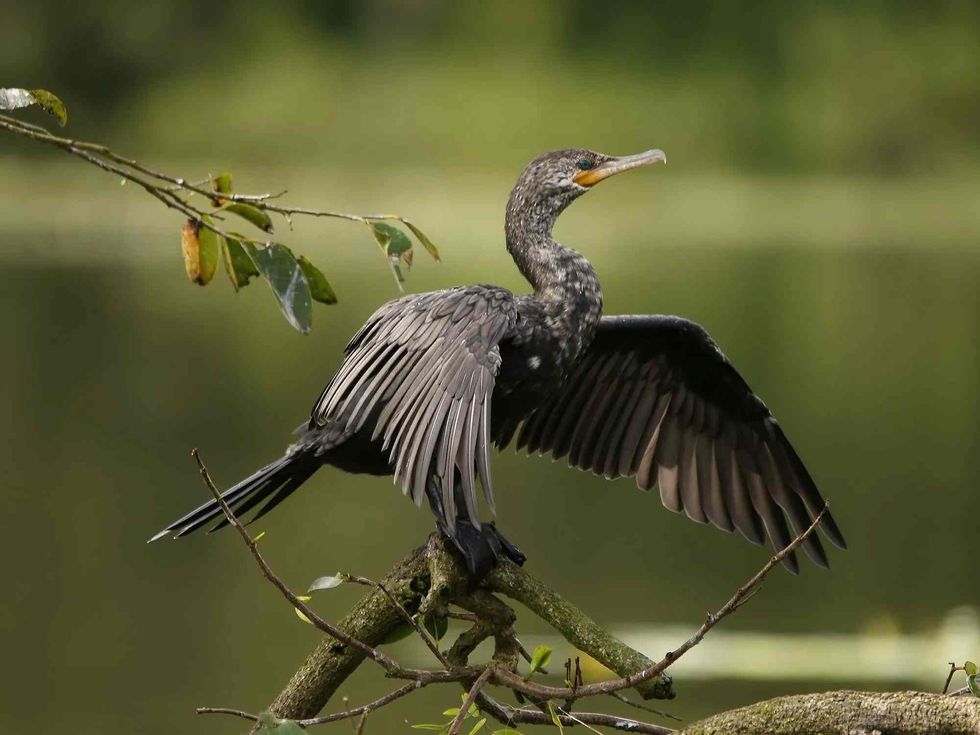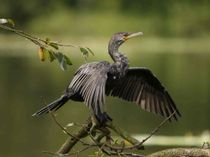The continents of North and South America have a varied and diverse list of birds and animals. From this list of wonderful animals, insects, and birds, we are going to the fish-eating aquatic bird, the Neotropic cormorant (Phalacrocorax brasilianus).
These birds belong to the order Suliformes, family Phalacrocoracidae. Spread all across the American landmass, these birds have two subspecies.
The first subspecies are found in Nicaragua and have the scientific name Phalacrocorax brasilianus mexicanus, while the second species is found on the South American continent and goes by the name Phalacrocorax brasilianus brasilianus.
More often than not, these birds are confused with the double-crested cormorant. However, differences between the two species of cormorants are easy to spot including the much smaller structure of the Neotropic variety.
So, scroll down and keep on reading to know more interesting physical and behavioral characteristics of the Neotropic cormorant. For information on other birds, take a look at the hooded crow and the green heron.
Neotropic Cormorant Interesting Facts
What type of animal is a Neotropic Cormorant?
The Neotropic cormorant (Phalacrocorax brasilianus) is a type of bird that is found on the North American and South American continents. This species of cormorant is often confused with the double-crested cormorant.
What class of animal does a Neotropic Cormorant belong to?
The Neotropic cormorant (Phalacrocorax brasilianus) belongs to the class of Aves and the order Suliformes, family Phalacrocoracidae. It is the same family to which the double-crested cormorant belongs as well.
How many Neotropic Cormorants are there in the world?
While the total number of these North American birds hasn't been estimated yet, there are certain population trends that we are aware of. In the southern US state of Texas, the population was said to have an annual increase in their approximate population of 3700 adult pairs of this aquatic bird.
Recent research from 2011 also indicates that the population of this bird has also seen an increment in the Ecuadorian regions of Southern America.
Where does a Neotropic Cormorant live?
Being aquatic birds, Neotropic cormorants are found in their nest and breeding sites along a range of water bodies like rivers, streams, and lakes. The Neotropic cormorant (Phalacrocorax brasilianus) is a species that is primarily thought to be North American.
These cormorants are found in places in North America like Texas, California, the Gulf coasts, New Mexico, Mexico, and Cuba. In the southern part of the American continental mass, Neotropics make their homes along rivers and lakes of Ecuador, Peru, Brazil, and other countries in South America.
What is a Neotropic Cormorant's habitat?
Because they are fish-eating birds, these cormorants always choose a site that is close to a source of water. This can include a range of marshy areas, swamps, rivers, inlets, lakes, and other bodies of water.
Interestingly, these birds have been observed at varying heights from sea level. They have been found in lowlands as well as spotted in lakes in the Andes mountain range running through South America.
For this species of cormorant, easy access to perches is important to their habitat and nest sites. This is because they love to bask their dark wet wings in the sun after they have foraged in the water looking for prey.
When drying their wings, Neotropic cormorants have been seen cleaning and preening. Some reports suggest that while cleaning their wings, they secrete oil from a gland near their tail.
In North America, neotropics are also found inhabiting brackish waters. If there is an island in the middle of a lake or a reservoir in areas of their habitat, you are bound to find nests of this species of birds in there.
The birds build their nests in tall shrubs or amongst dead trees. Sometimes, you will find this species of fish-eating cormorant building its nest on man-made structures or even on elevated bare ground.
Who do Neotropic Cormorants live with?
You may be surprised to know that adult Neotropic cormorants are generally solitary with two exceptions. These exceptions are occasions when the birds feed together in flocks and when the breeding season starts.
How long does a Neotropic Cormorant live?
The lifespan of the Neotropic cormorant varies between the range of eight to 10 years. However, there are conflicting reports on the oldest bird that has been caught for this species.
Some claim that the oldest Neotropic bird was at the age of 11 years and nine months and was found in the state of Louisiana. While the other claim is that the oldest Neotropic bird was the age of 12 years and seven months. The generation length of these cormorants is thought to be about eight years.
How do they reproduce?
The breeding between the males and the females of this species of bird is quite interesting. Depending on their location, the breeding season between the birds lasts usually from June until the end of November.
Despite the long breeding season, this species of bird are known to produce just a single brood of eggs per year. The male birds woo the female birds with a variety of displays and a particular mating call. The swaying of the necks and flapping of the wings are popular courtship rituals for these cormorants.
Once mated, a pair of cormorants are monogamous for life. Males already select the nest sites before indulging in displays, however, both sexes of this species build the nest.
The female bird gives birth to an average of three or four eggs with the range varying between one and six eggs. The eggs are then incubated for a period of three or four weeks and after they hatch, the young ones are taken care of by both their parents.
The young bird will leave the nest after 12 weeks.
What is their conservation status?
The fish-eating Neotropic cormorants aren't in any imminent danger of a decreasing population. They have been classified as the species belonging to the Least Concern status in the Red List maintained by the International Union For Conservation Of Nature or the IUCN.
Neotropic Cormorant Fun Facts
What do Neotropic Cormorants look like?

These birds are often confused with similar species like the double-crested cormorant. The plumage of this bird is mainly black. The region of their neck called the gular is orangish-yellow in coloration.
In contrast, young juveniles are usually brown in their plumage color. The wings are broad with a tinge of olive in them.
In their body structure, this bird is pretty thin with a long neck. At the end of their bill, these fish-eating cormorants have a hooked tip. With the cormorants being aquatic birds, their swimming abilities are enhanced by their webbed feet.
How cute are they?
Although these fish-eating birds are not very colorful to look at, their mannerisms and overall appearance can be deemed adorable by some.
How do they communicate?
The call of these birds is usually a very low and guttural croak and grunt. These calls are often compared to the sound of a pig. During the breeding season, displays of wings flapping and calls are commonplace. Once that period is over, these birds are generally quiet.
How big is a Neotropic Cormorant?
The Neotropic cormorant is a slender and small bird. They have a length that can range within 24 in (61 cm) with a 40 in (101 cm) wingspan. In comparison, the double-crested cormorant is slightly bigger with a length range of 27-35 in (68.5-89 cm).
How fast can a Neotropic Cormorant fly?
Although the flying speed of the neotropics is not known, some species of the fish-eating cormorant family can gain speeds up to 35mph.
How much does a Neotropic Cormorant weigh?
The weight of this species of cormorant is thought to be between 37.7-52.9 oz (1.06-1.5 kg).
What are the male and female names of the species?
Males and females of this species are not known by any distinct names.
What would you call a baby Neotropic Cormorant?
Young neotropics can be called hatchlings or chicks.
What do they eat?
Being one of the few birds and the only cormorant species that dive into the water at less than two ft, the neotropics mainly feed on a diet of fish, dragonfly nymphs, tadpoles, and other amphibians. Their fish diet includes the Atlantic croaker, the pugnoe minnow, and the spotted gar amongst others.
Are they dangerous?
Well, they are dangerous for our fish friends but they are not capable of causing any severe harm to humans. Any number of scare tactics can be used to shoo away this highly alert bird.
Would they make a good pet?
Due to these birds being aquatic, they need a deep source of water to survive. Hence, we cannot suggest them as pets for you.
Did you know...
The Uru tribe in Peru uses these birds for fishing.
In South America, these birds are known by the name, ‘bigua’.
These birds are not migratory at all.
Sometimes in North America, anhingas are confused with Neotropic cormorants.
What is special about the Cormorant?
These cormorants can stay underwater for around up to 15 seconds. Some might think that the feathers getting wet might be a problem for the bird, but in reality, it helps them to dive deeper into the water.
What do Neotropic Cormorants symbolize?
There aren't many metaphorical symbols associated with the Neotropic cormorant. However, cormorants, in general, are thought to be symbolic of nobility and plentifulness. They are also a sign of good times for fishermen as they indicate that the water bodies are full of fish.
Here at Kidadl, we have carefully created lots of interesting family-friendly animal facts for everyone to discover! Learn more about some other birds including the great cormorant and the black-browed albatross.
You can even occupy yourself at home by drawing one of our neotropic cormorant coloring pages.










